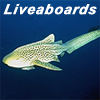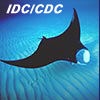Reef Ecology Guide Phuket Thailand - Bony Fishes 4
TRUMPETFISHES (Aulostomidae)

In the Similans and around Phuket we find only one species, Aulostomus chinensis. Body very elongated and slightly compressed. Head compressed, snout tubular and oversized. Caudal fin small and lanceolate. Our Indo-Pacific species is widespread in tropical seas. Easily identified by their robust body and color.
The only similar species are the CORNETFISHES (Fistularidae), which are very plain and more slender with a long filament on the center of the caudal fin.
The bright yellow phase is usually noticed most, although the normal brownish or gray form is more common. In general the color is variable between juveniles and adult, from longitudinal bands to vertical banding. They have the ability to quickly change color.
The trumpet fish feeds on other fish and the mouth can open surprisingly wide, creating a strong suction in the process.
PIPEFISHES AND SEAHORSES (Syngnathidae)

This family comprises some of the most interesting fishes in both behavior and appearance. This large family is distributed globally in all but the coldest seas and some occur in freshwater.
Mostly slender fishes, bodies scale less, encased in bony plates, arranged in series of rings. A small oblique mouth at the end of a tubular snout. Ventral fins and jaw teeth are absent. The tail is prehensile in some species.
Usually the species live on shallow reefs or in sea grass beds, feeding primarily on small crustaceans which are sucked up with the long snout. Their reproduction method is unique, as males incubate the eggs in a pouch on the tail or belly. Hatchlings are often well advanced and may already resemble its parents.
Close related to Syngnathidae are the GHOST PIPE FISHES (Solenostomidae). In this small tropical family the females incubate the eggs. Their ventral fin is enlarged and hooked onto the body to form a pouch for holding the eggs.
TIGERTAIL SEAHORSE (Hippocampus comes)
 Length: to 15 cm
Length: to 15 cm
This seahorse species lives in habitats rich in soft corals and sponges.
Its coloration is yellow to black: males are usually dark, females are often yellow. The tail shows contrasting bands of dark and yellow.
TAIL-LESS PIPEFISH (Trachyrhampus bicoarctatus)
 Length: to 40 cm
Length: to 40 cm
Inhabits clear sandy bays, lying low on substrate near algae or loose weed.
Feeds on small crustaceans. As they reach adulthood, they loose their caudal fin.
DAMSELFISHES (Pomacentridae)

Damselfishes are a very large family, particularly in tropical coral reef habitats. Most species do not exceed 10 cm in length.
Habitats are nearly always reefs which features plenty of cover such as small crevices. Basically, those species that are algae feeders occupy the shallow reef flats and planktivore species occupy the rocky outcrops.
Damselfishes are very popular, in particular the anemone or clown fishes which are not only very colorful but have a close relationship with large anemones. The anemone fish live amongst the tentacles without getting stung, because the anemone reacts to the fish contact as if it were another tentacle.
The benefit for the anemone is, that the fish protect its host against enemies like butterfly fishes, which may attack and eat the anemone. The territories of anemone fishes are small, not expanding much beyond the anemone.
CLARK'S ANEMONEFISH (Amphiprion clarkii)
 Length: to 10 cm
Length: to 10 cm
Widely distributed with different color morphs, usually black with variable amounts of orange on head and fins and three white bars on head, body and base of the tail fin.
This species is not host-specific: associated with at least 10 anemone species.
HAWKFISHES (Cirrhitidae)

The hawk fishes are a tropical family common to our area. These small fishes hug the bottom, perched on the thickened lower pectoral fin rays, but unlike most bottom dwellers they are very active, often restlessly moving positions.
Most species live in shallow water, on reef crests and strong surge zones. Most species are habitat specific, found with certain sponges or corals and usually occur in loose aggregations. They are carnivores, feeding on small fishes and invertebrates.
In general hawk fishes are small and less than 10 cm long, but a few attain almost 30 cm. Filaments at the tip of the dorsal spines, often tufted, are diagnostic for the family.
SPOTTED HAWKFISH (Cirrhitichthys oxycephalus)
 Length: to 10 cm
Length: to 10 cm
Inhabits areas of rich coral growth and the clear water of lagoons. It rests on, in or beneath hard or soft corals.
Usually observed singly. Coloration varies from dark to light red to suit various habitats.
Dive Asia - Phuket Thailand
Office Address: 8/30 Soi Yodsanee, Chalong, Phuket 83150, Thailand
Phone: +66 (0) 818948588 or 0899736005
Visit us at one of our Offices: (Google Map)
Email:
Website: www.diveasia.com
24 Hour Hotline: +66 (0) 818948588









 Length: to 12 cm
Length: to 12 cm Length: to 12 cm
Length: to 12 cm








